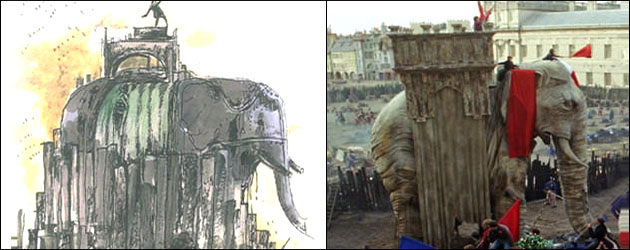Eve Stewart

AS: Was everything built on stage for Les Misérables?
ES: Almost everything was a set on a stage, yes. With the exception of the outside where we did the funeral and the big elephant scene.
AS: Was the elephant based on something that actually existed?
ES: Yes, it was in the original novel. So I read the novel thoroughly and I found out that this elephant had been constructed by Napoleon to celebrate his successes in Egypt. It was made out of plaster and began to rot when he ran out of money. And in the novel Gavroche and all the other little urchins of Paris live in it.
AS: Was it a huge construction?
ES: It was a massive construction! It was 48 feet high and you could climb up inside it. We had one big enormous studio in Pinewood. It must have been about 250 feet by 130 feet and by the end with all our sets we only had about ten foot left and all the monitors and stuff had to be snuck in around the back one of the sheds.
AS: I remember you saying that you had read the full novel but not everyone in the crew had.
ES: Yes, I think it was only myself and Tom! It’s got 1406 pages of really tiny writing!
AS: Were you involved in the visual effects a lot?
ES: Yeah, we were involved in the visual effects a lot primarily because we had done all the research on all the buildings that would have been around that street in Paris. We made quite a lot of big 3D models of the buildings that they could photograph and use within their composites.
AS: Was that part of your pre-vis?
ES: It was my version of a pre-vis. [Producer] Cameron Mackintosh works in theater all the time. They’re very used to seeing a big model of what the scenery would be. I made this giant, accurate model where the buildings were very realistic, and each about two foot high and all painted and colored like doll’s houses so everybody was very clear about what they would get.
AS: A lot of production designers I talk to just do 3D models on computers. But there’s something kind of magical about a physical model that people can look at.
ES: Yes, I agree, I think there is something magical. They’re both very useful tools but I don’t think you can completely just work with computer generated images because they never show the texture or the soul of the thing.
CG is very useful. It’s a quick way of working. But in the end it’s all about human beings and how they interact with the surfaces.
AS: With the sets in Les Misérables did you have to change a lot to accommodate the choreography as soon as they started singing and dancing?
ES: Only a little bit in the scene with all the prostitutes. When Tom saw the set he loved all the bits along the high walls so he began to want the ladies writhing around on them. We had to make a lot of them a lot stronger to take their weight.
This is a very interesting conversation. Thank you for sharing your insights about the production design and entertainment industry! As a student aspiring to one day work in the entertainment or production industry these insights are very inspiring and helpful in career planning. Wish you the best in all your endeavors! Keep up the incredibly beautiful work.